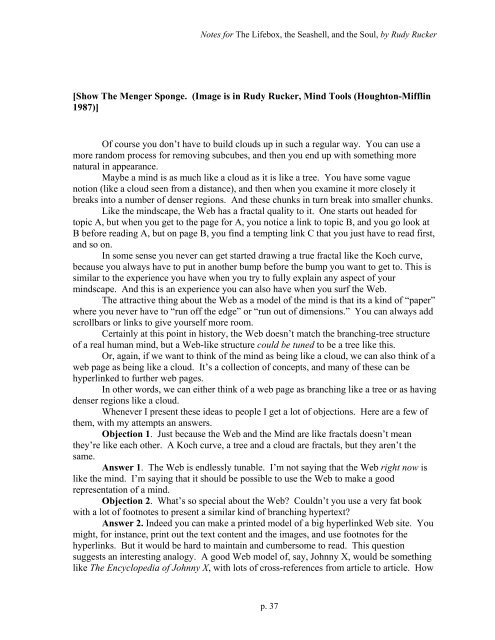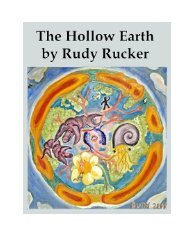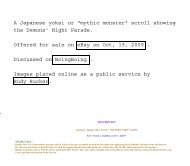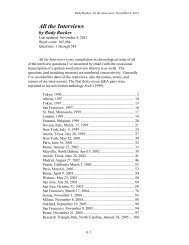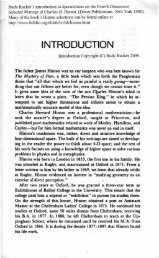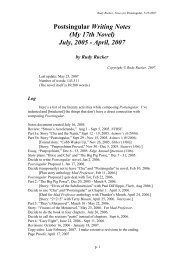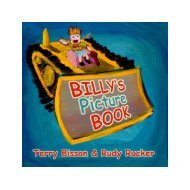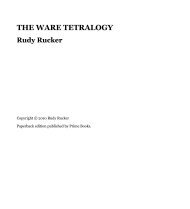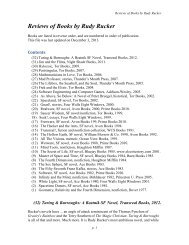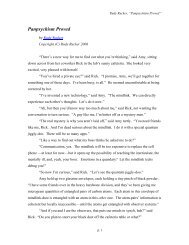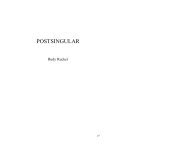Notes for the Lifebox, the Seashell, and the Soul - Rudy Rucker
Notes for the Lifebox, the Seashell, and the Soul - Rudy Rucker
Notes for the Lifebox, the Seashell, and the Soul - Rudy Rucker
You also want an ePaper? Increase the reach of your titles
YUMPU automatically turns print PDFs into web optimized ePapers that Google loves.
<strong>Notes</strong> <strong>for</strong> The <strong>Lifebox</strong>, <strong>the</strong> <strong>Seashell</strong>, <strong>and</strong> <strong>the</strong> <strong>Soul</strong>, by <strong>Rudy</strong> <strong>Rucker</strong><br />
[Show The Menger Sponge. (Image is in <strong>Rudy</strong> <strong>Rucker</strong>, Mind Tools (Houghton-Mifflin<br />
1987)]<br />
Of course you don’t have to build clouds up in such a regular way. You can use a<br />
more r<strong>and</strong>om process <strong>for</strong> removing subcubes, <strong>and</strong> <strong>the</strong>n you end up with something more<br />
natural in appearance.<br />
Maybe a mind is as much like a cloud as it is like a tree. You have some vague<br />
notion (like a cloud seen from a distance), <strong>and</strong> <strong>the</strong>n when you examine it more closely it<br />
breaks into a number of denser regions. And <strong>the</strong>se chunks in turn break into smaller chunks.<br />
Like <strong>the</strong> mindscape, <strong>the</strong> Web has a fractal quality to it. One starts out headed <strong>for</strong><br />
topic A, but when you get to <strong>the</strong> page <strong>for</strong> A, you notice a link to topic B, <strong>and</strong> you go look at<br />
B be<strong>for</strong>e reading A, but on page B, you find a tempting link C that you just have to read first,<br />
<strong>and</strong> so on.<br />
In some sense you never can get started drawing a true fractal like <strong>the</strong> Koch curve,<br />
because you always have to put in ano<strong>the</strong>r bump be<strong>for</strong>e <strong>the</strong> bump you want to get to. This is<br />
similar to <strong>the</strong> experience you have when you try to fully explain any aspect of your<br />
mindscape. And this is an experience you can also have when you surf <strong>the</strong> Web.<br />
The attractive thing about <strong>the</strong> Web as a model of <strong>the</strong> mind is that its a kind of “paper”<br />
where you never have to “run off <strong>the</strong> edge” or “run out of dimensions.” You can always add<br />
scrollbars or links to give yourself more room.<br />
Certainly at this point in history, <strong>the</strong> Web doesn’t match <strong>the</strong> branching-tree structure<br />
of a real human mind, but a Web-like structure could be tuned to be a tree like this.<br />
Or, again, if we want to think of <strong>the</strong> mind as being like a cloud, we can also think of a<br />
web page as being like a cloud. It’s a collection of concepts, <strong>and</strong> many of <strong>the</strong>se can be<br />
hyperlinked to fur<strong>the</strong>r web pages.<br />
In o<strong>the</strong>r words, we can ei<strong>the</strong>r think of a web page as branching like a tree or as having<br />
denser regions like a cloud.<br />
Whenever I present <strong>the</strong>se ideas to people I get a lot of objections. Here are a few of<br />
<strong>the</strong>m, with my attempts an answers.<br />
Objection 1. Just because <strong>the</strong> Web <strong>and</strong> <strong>the</strong> Mind are like fractals doesn’t mean<br />
<strong>the</strong>y’re like each o<strong>the</strong>r. A Koch curve, a tree <strong>and</strong> a cloud are fractals, but <strong>the</strong>y aren’t <strong>the</strong><br />
same.<br />
Answer 1. The Web is endlessly tunable. I’m not saying that <strong>the</strong> Web right now is<br />
like <strong>the</strong> mind. I’m saying that it should be possible to use <strong>the</strong> Web to make a good<br />
representation of a mind.<br />
Objection 2. What’s so special about <strong>the</strong> Web? Couldn’t you use a very fat book<br />
with a lot of footnotes to present a similar kind of branching hypertext?<br />
Answer 2. Indeed you can make a printed model of a big hyperlinked Web site. You<br />
might, <strong>for</strong> instance, print out <strong>the</strong> text content <strong>and</strong> <strong>the</strong> images, <strong>and</strong> use footnotes <strong>for</strong> <strong>the</strong><br />
hyperlinks. But it would be hard to maintain <strong>and</strong> cumbersome to read. This question<br />
suggests an interesting analogy. A good Web model of, say, Johnny X, would be something<br />
like The Encyclopedia of Johnny X, with lots of cross-references from article to article. How<br />
p. 37


